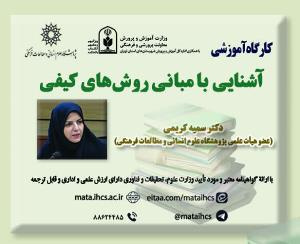شناخت، سنجش و ارزیابی عوامل موثر بر فساد اداری در بخش دولتی استان خوزستان با استفاده از مدل سه شاخگی (مطالعه ای در بین دستگاه های اجرایی منتخب) (مقاله علمی وزارت علوم)
درجه علمی: نشریه علمی (وزارت علوم)
آرشیو
چکیده
فساد اداری یکی از مهم ترین مشکلات سازمان های دولتی در کشورهای جهان سوم می باشد که بسیاری از دستاوردهای سازمانی را تضعیف کرده یا از بین می برد. تحقیق حاضر به دنبال شناخت، سنجش و ارزیابی عوامل مؤثر بر فساد اداری در بخش دولتی استان خوزستان می باشد. این پژوهش با روش آمیخته (کیفی و کمی) انجام گرفت. جامعه آماری شامل سازمان های بزرگ دولتی بوده و چهار سازمان آب و فاضلاب استان خوزستان، اداره کل گمرک استان خوزستان، اداره کل راه و شهرسازی خوزستان و سازمان صنعت، معدن و تجارت استان خوزستان می باشد که با استفاده از روش گلوله برفی 12 نفر از خبرگان این سازمان ها مورد مصاحبه قرار گرفتند و نتایج آن به کمک روش تحلیل محتوای کیفی تحلیل شد. سپس پرسشنامه ای تدوین گردید و پس از تأیید روایی (صوری و محتوا) و پایایی (آلفای کرونباخ، 80/0) آن در اختیار 215 نفر از کارشناسان سازمان های منتخب دولتی قرار گرفت که در شرایط بیماری همه گیرکوید 19 به روش نمونه گیری تصادفی ساده انتخاب شدند. داده ها به کمک نرم افزارSPSS و AMOSEبه روش تحلیل عاملی تاییدی، آزمون تی تک نمونه ای و آزمون فریدمن مورد تجزیه و تحلیل قرار گرفتند. نتایج نشان داد که سنجه ها دارای میانگین بالای عدد 3 هستند و بنابراین از نظر کارشناسان در بروز فساد اداری با اهمیت می باشند. همچنین از بین عوامل محیطی، متغیر نظام سیاسی و حکومتی، از بین عوامل سازمانی، ساختار مدیریتی و از بین عوامل فردی، خصوصیات فردی بیشترین امتیاز را آوردند. از بین مدل سه شاخگی عوامل مؤثر بر بروز فساد اداری، عوامل سازمانی مهم ترین عامل در بروز فساد اداری بود.Recognition, measurement and evaluation of factors affecting corruption in the public sector of Khuzestan province using a three-pronged model (a study among selected executive bodies)
Administrative corruption is one of the most important problems of government organizations in third world countries, which weakens or destroys many organizational achievements. The present research seeks to identify, measure and evaluate the factors affecting administrative corruption in the public sector of Khuzestan province. This research was conducted with a mixed method (qualitative and quantitative). The statistical population includes large government organizations and four water and sewage organizations of Khuzestan province, the General Administration of Customs of Khuzestan Province, the General Administration of Roads and Urban Development of Khuzestan Province and the Organization of Industry, Mining and Trade of Khuzestan Province. Using the snowball method, 12 experts of this The organizations were interviewed and the results were analyzed using the qualitative content analysis method. Then, a questionnaire was developed and after verifying the validity (form and content) and reliability (Cronbach's alpha, 0.80) it was given to 215 experts from selected government organizations, who were selected by simple random sampling in the conditions of the epidemic of covid-19. became The data were analyzed using SPSS and AMOSE software using confirmatory factor analysis, one-sample t-test and Friedman test. The results showed that the indicators have a high average number of 3 and therefore, according to experts, they are important in the occurrence of administrative corruption. among the environmental factors, political and government system variable, among the organizational factors, management structure and among the individual factors, individual characteristics got the most points. Among the three-pronged model of factors affecting the occurrence of administrative corruption, Organizational factors were the most important factors in the occurrence of administrative corruption.IntroductionAdministrative corruption is one of the most important problems of government organizations in third world countries, which weakens or destroys many organizational achievements.Case studyThe present research seeks to identify, measure and evaluate the factors affecting administrative corruption in the public sector of Khuzestan province. This research was conducted with a mixed method (qualitative and quantitative). The statistical population includes large government organizations and four water and sewage organizations of Khuzestan province, the General Administration of Customs of Khuzestan Province, the General Administration of Roads and Urban Development of Khuzestan Province and the Organization of Industry, Mining and Trade of Khuzestan Province.Materials and MethodsUsing the snowball method, 12 experts of this The organizations were interviewed and the results were analyzed using the qualitative content analysis method. Then, a questionnaire was developed and after verifying the validity (form and content) and reliability (Cronbach's alpha, 0.80) it was given to 215 experts from selected government organizations, who were selected by simple random sampling in the conditions of the epidemic of covid-19. became The data were analyzed using SPSS and AMOSE software using confirmatory factor analysis, one-sample t-test and Friedman test. Discussion and ResultsThe results showed that the indicators have a high average number of 3 and therefore, according to experts, they are important in the occurrence of administrative corruption.Conclusion:among the environmental factors, political and government system variable, among the organizational factors, management structure and among the individual factors, individual characteristics got the most points. Among the three-pronged model of factors affecting the occurrence of administrative corruption, Organizational factors were the most important factors in the occurrence of administrative corruption.







